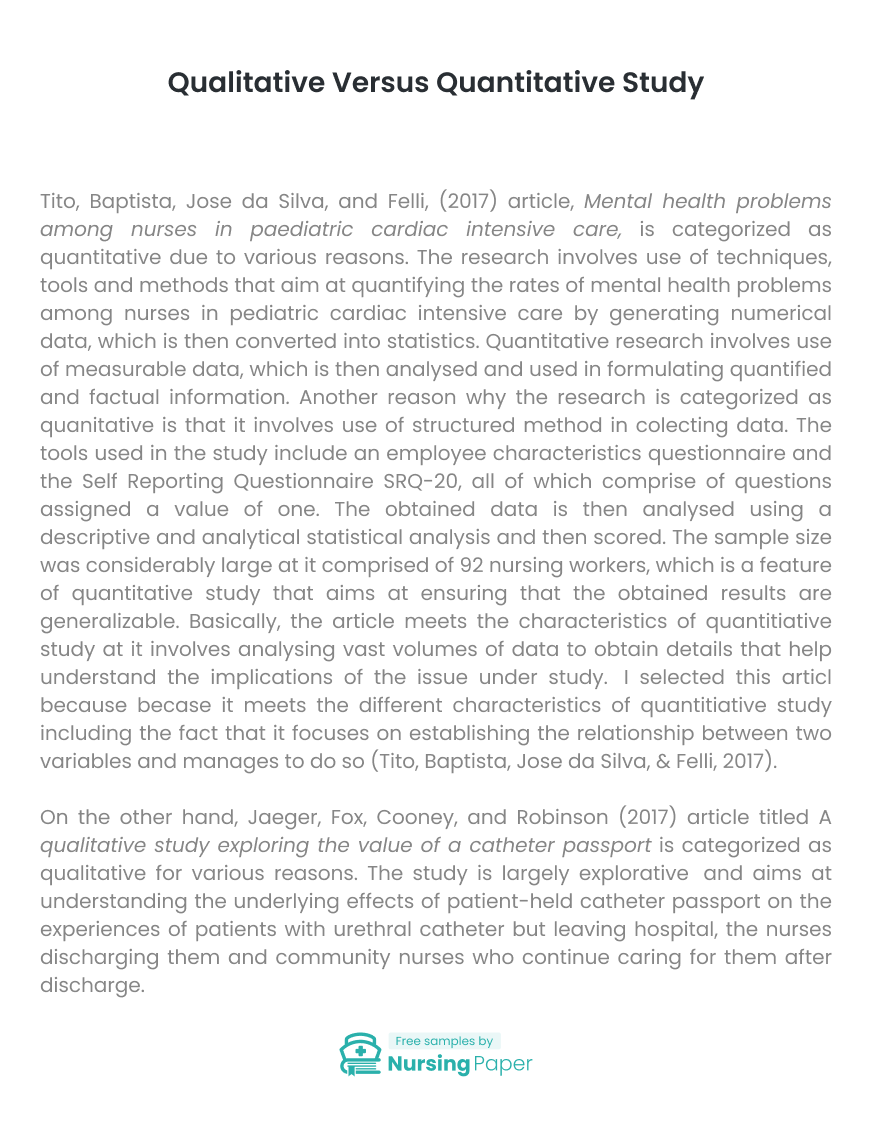
Qualitative Versus Quantitative Study
Introduction
Tito, Baptista, Jose da Silva, and Felli, (2017) article, Mental health problems among nurses in paediatric cardiac intensive care, is categorized as quantitative due to various reasons. The research involves use of techniques, tools and methods that aim at quantifying the rates of mental health problems among nurses in pediatric cardiac intensive care by generating numerical data, which is then converted into statistics. Quantitative research involves use of measurable data, which is then analysed and used in formulating quantified and factual information. Another reason why the research is categorized as quanitative is that it involves use of structured method in colecting data. The tools used in the study include an employee characteristics questionnaire and the Self Reporting Questionnaire SRQ-20, all of which comprise of questions assigned a value of one. The obtained data is then analysed using a descriptive and analytical statistical analysis and then scored. The sample size was considerably large at it comprised of 92 nursing workers, which is a feature of quantitative study that aims at ensuring that the obtained results are generalizable. Basically, the article meets the characteristics of quantitiative study at it involves analysing vast volumes of data to obtain details that help understand the implications of the issue under study. I selected this articl because becase it meets the different characteristics of quantitiative study including the fact that it focuses on establishing the relationship between two variables and manages to do so (Tito, Baptista, Jose da Silva, & Felli, 2017).
On the other hand, Jaeger, Fox, Cooney, and Robinson (2017) article titled A qualitative study exploring the value of a catheter passport is categorized as qualitative for various reasons. The study is largely explorative and aims at understanding the underlying effects of patient-held catheter passport on the experiences of patients with urethral catheter but leaving hospital, the nurses discharging them and community nurses who continue caring for them after discharge. Qualitative study focus on providing insights and trenads and entail use of unstructured and semi-structured techniques. The study also involved use of qualitative strategies such as focus groups, interviews, questionnaires and thematic analysis. The information collected using these tools was then used to describe the issue under study and help provide more information as opposed to measuring it. The sample size was small at it comprised of nine patients, 6 hospitals nurses and 5 community nurses, which is a characteristic of qualiative reearch. I choose this article because it is eer reviewed and up to date. Moreover, the researchers clearly assert that the aim of their study is to help gain understanding of an underlying reason and provide insights to help improve on how the issue is addressed (Jaeger, Fox, Cooney, & Robinson, 2017).


Both articles were obtained from the British Journal of Nursing, which is a popular journal that contains peer reviewed articles on health issues particularly in the field of nursing. The articles are actually subjected to double-blind peer review. The authority of BJN is evident in that the articles from the journal are indexed in popular databases such as PubMed, CINAHL, and The International Nursing Index. The journal has clear guidelines regarding publication to articles, which help ensure that all published articles are relevant to nursing, containe information that backed up with up to date references.
1. Jaeger, M., Fox, F., Cooney, G., & Robinson, J. (2017). A qualitative study exploring the value of a catheter passport. British Journal of Nursing, 26(15), 857-866.
2. Tito, R., Baptista, P., Jose da Silva, F., & Felli, V. (2017). Mental health problems among nurses in paediatric cardiac intensive care. British Journal of Nursing, 26(15), 870-873.



The download will start shortly.

The download will start shortly.
 Subject:
Health and Social Care
Subject:
Health and Social Care  Number of pages: 5
Number of pages: 5  Subject:
Nursing
Subject:
Nursing  Number of pages: 3
Number of pages: 3  Subject:
Health and Social Care
Subject:
Health and Social Care  Number of pages: 12
Number of pages: 12  Subject:
Medicine
Subject:
Medicine  Number of pages: 6
Number of pages: 6  Subject:
Health and Social Care
Subject:
Health and Social Care  Number of pages: 4
Number of pages: 4  Subject:
Medicine
Subject:
Medicine  Number of pages: 6
Number of pages: 6  Subject:
Health and Social Care
Subject:
Health and Social Care  Number of pages: 4
Number of pages: 4  Subject:
Medicine
Subject:
Medicine  Number of pages: 5
Number of pages: 5  Subject:
Health and Social Care
Subject:
Health and Social Care  Number of pages: 6
Number of pages: 6  Subject:
Health and Social Care
Subject:
Health and Social Care  Number of pages: 2
Number of pages: 2  Subject:
Nursing
Subject:
Nursing  Number of pages: 3
Number of pages: 3  Subject:
Health and Social Care
Subject:
Health and Social Care  Number of pages: 8
Number of pages: 8  Subject:
Health and Social Care
Subject:
Health and Social Care  Number of pages: 1
Number of pages: 1  Subject:
Health and Social Care
Subject:
Health and Social Care  Number of pages: 2
Number of pages: 2  Subject:
Nursing
Subject:
Nursing  Number of pages: 8
Number of pages: 8 
